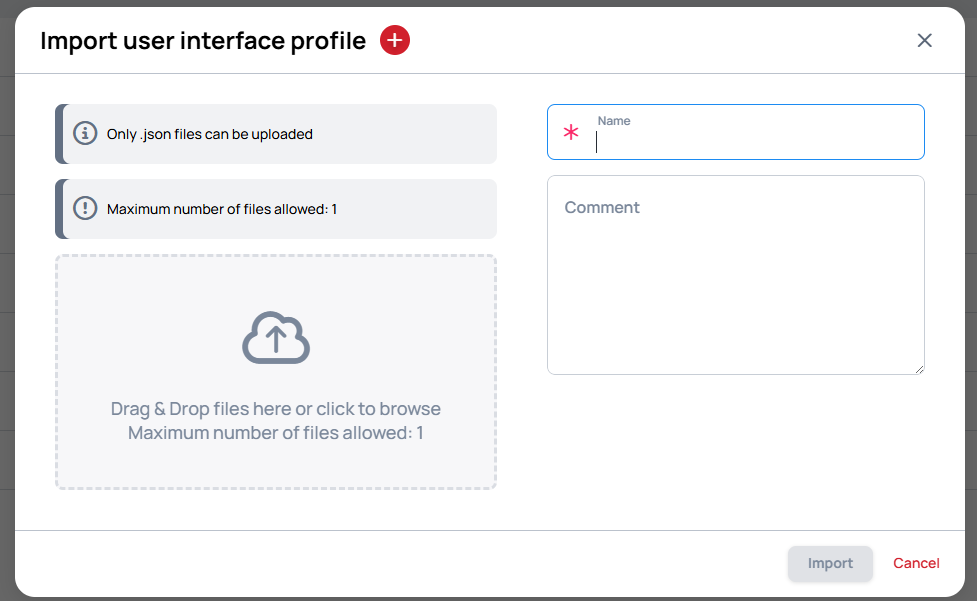User Interface Profile settings
The User Interface Profile system allows you to control which elements of the user interface are visible to individual users based on their role and assigned permissions.
- This helps streamline the experience and ensure users only see what’s relevant to them.
Each user in the system has their own User Interface Profile settings.
-
These settings determine the visibility of UI components for that specific user.
- If you've never modified your user's or client's UI profile, it likely uses the default settings that mean all permissions are set to
inherit.
- If you've never modified your user's or client's UI profile, it likely uses the default settings that mean all permissions are set to
-
You can override this behavior by assigning a UI Profile preset to the user during or after account creation or in the edit modal.
Permission States
Inherit
The default state for most permissions.
- The visibility setting is inherited from the next level in the permission hierarchy.
- This state allows flexibility and avoids redundant configuration.
Show
Explicitly makes the UI element visible to the user.
- This setting overrides inherited permissions from presets or customer-level settings (unless blocked by role-based restrictions).
Hide
Explicitly hides the UI element from the user.
- This is the strongest setting. Once a permission is set to
hide, it cannot be overridden by lower-level presets or inherited values. - Use with caution, as it can completely remove access to important functionality.
- If a user’s role does not meet the required minimum role to access certain UI elements or manage specific features, those permissions will be automatically set to
hideand cannot be changed, even if other settings (like presets or inheritance) would normally allow them. - If the visibility of all subsections under a main menu is disabled, the entire menu will automatically become hidden (permission state: hide(inherit)).
Understanding Permission Levels
There are three levels at which UI profile permissions can be set.
They follow a strict hierarchy of precedence:
User-Level Permissions (Strongest)

These settings apply directly to an individual user and take precedence over any presets or customer-level settings.
- Accessed via: Settings >> Users >> User Interface Profile Settings
- If a permission is set to
hideat this level, it cannot be overridden by other settings.
User Interface Profile Presets

These are reusable permission templates that can be assigned to users.
- While useful for setting default visibility, they can be overridden by user-level settings.
Add User Interface Profile Presets
- Navigate yourself to Settings >> select User menu >> User Interface Profiles tab.
Assign User Interface Profile Presets
- There you can add new User Interface Profile presets that can be applied to the desired user.
- You can assign these presets to a user in the creation modal or in the edit modal by selecting it in the
User Interface Profilesdropdown.
Export and Import User Interface Profile Presets
You can export and import User Interface Profile presets to transfer configurations between users or backup your settings:
Export UI Profile:
- Navigate to Settings >> Users >> User Interface Profiles tab
- Select the UI Profile preset you want to export
- Click the export option to download the profile configuration as a JSON file
- The exported file contains all permission settings for that profile
Import UI Profile:
- Navigate to Settings >> Users >> User Interface Profiles tab
- Click the import option
- Upload the previously exported UI Profile JSON file (drag & drop or browse)
- Enter a name for the imported profile
- Optionally add a comment to describe the profile
- Click Import to add the profile to your available presets

This feature is useful for:
- Replicating UI configurations across multiple users
- Backing up custom profile configurations
- Sharing standardized profiles between different Wallboard instances
- Quickly setting up new users with predefined access patterns
Customer-Level Permissions
With these settings, you can restrict UI elements customer wide (e.g., hide items that are otherwise shown in a preset).
- However, user-level permissions can override these restrictions.
- You can assign User interface profile settings to your customer by accessing the Preferences modal >> Other settings >> User interface profiles
Important Notes
Some permissions are not available for lower-level roles due to restricted functionalities.
The affected permissions will be marked as hidden even if they were set to inherit before.
- Permissions hidden by user role settings CANNOT be set to
show
Learn more: User Roles (2.0)